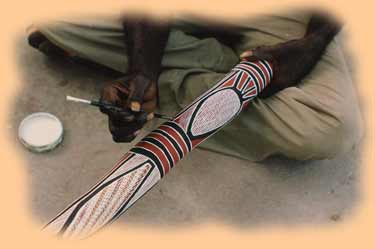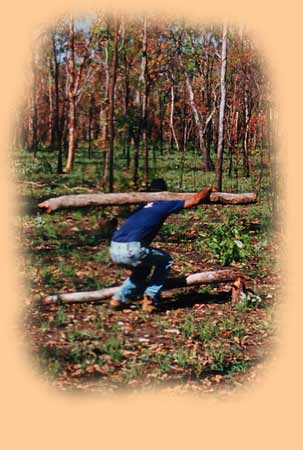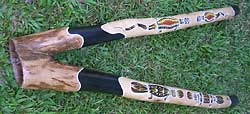 This article
endeavours to explore how your purchase of a didgeridoo can affect Australian Aboriginal people and to give you a better understanding of the
didgeridoo industry. This article
endeavours to explore how your purchase of a didgeridoo can affect Australian Aboriginal people and to give you a better understanding of the
didgeridoo industry.
What is an Authentic Aboriginal Didgeridoo? The word authentic is used in the sale of a lot of didgeridoos, most of which are
far from authentic.
Many Australian didgeridoo sellers seem to believe that a didgeridoo is authentic as long as they can get some sound out of it .They also consider
any didj to be Aboriginal, even if no Aboriginal ever touched it, simply because the didgeridoo is a traditional Aboriginal instrument.
Australian Aborigines however consider a didgeridoo to be an authentic Aboriginal didgeridoo only if the didgeridoo is genuine termite hollowed
AND made by an Aboriginal.
1. Genuine termite hollowed didgeridoos harvested by Aborigines
Since the sound of the didgeridoo has captured the hearts of millions all over the earth with the help of David Blanasi, Rolf
Harris, Yothu Yindi, the Sydney Olympics and others, many people want to own one of these ancient Aboriginal instruments.
This has created a steeply growing demand for didgeridoos.
Aboriginal people generally welcome this strong interest in the didgeridoo especially since there is a corresponding growth in
interest for their ancient culture.
Today there are many more Aboriginal people cutting didgeridoos than there have ever been. There are also many Aboriginal artists
finding employment by painting didgeridoos. So there is a definite positive effect for these Aborigines who are directly involved in didgeridoo
production as well as their families and clans.
 Another positive effect
is that for many Aborigines, seeing Aboriginal artifacts in shops and experiencing the interest from tourists has awakened a renewed interest
in their own culture. Another positive effect
is that for many Aborigines, seeing Aboriginal artifacts in shops and experiencing the interest from tourists has awakened a renewed interest
in their own culture.
Most Aborigines in Australia have a very low self esteem. Aborigines depend on a very strong connection to the land and the non-Aboriginal policy of taking
Aborigines away from their land into Christian missions in other parts of the country has resulted in Aborigines feeling disconnected, lost and
without direction in their life's. There are many drunken Aborigines in many Australian cities and towns who have lost their spirit.
Some of these Aborigines now show renewed interest in their culture and find new meaning for their life. Tribes start doing corroborees
again which they have not done since non-Aboriginal man stopped them. Clans are making their ancient artifacts again which were nearly forgotten; some
young Aboriginals express interest in learning the old songs. For many Aboriginal tribes this renewed interest comes just in time as the last
elders holding this knowledge are passing on. Here in our local Tjapukai tribe the local language was only preserved due to the interest of a
non-Aboriginal man, Michael Booth, who learned the language from the elders when Aboriginal youth had no interest. Now that those elders have died, he
is teaching the language to the Aboriginal youth again after their interest in their culture and language has rekindled. He has also helped to
create a language text book for the school system.
2 . Genuine termite hollowed didgeridoos harvested by non-Aborigines
 However the huge
demand for didgeridoos has also attracted a lot of non-Aboriginal people in pursuit of a quick dollar. However the huge
demand for didgeridoos has also attracted a lot of non-Aboriginal people in pursuit of a quick dollar.
Sadly many shady operators have set up business in the didgeridoo industry in search of getting rich quick.
Allow me to share a few stories about the "white" didgeridoo industry I have heard on the grapevine (I cannot guarantee
the accuracy of any of these stories, but they might give you some idea of what is going on in some sections of the Australian didj industry):
- stories that shops selling "Authentic Aboriginal Didgeridoos" might have some Aboriginal made didgeridoos, but
sell mostly didges illegally cut by non-Aboriginal people without pointing out to customers that the didgeridoo they just bought is not an authentic Aboriginal
didgeridoo
- stories from Arnhem Land tribes that non-Aboriginal people are cutting didgeridoos on Aboriginal land without permission from the
traditional owners (they consider this to be actual and not just cultural theft, but with the vast areas involved, its unlikely someone will
get caught red-handed),
- stories that operators claiming to cut in the vicinity of 100 didgeridoos a day have a permit from forestry to cut only
a few thousand a year (meaning they cut ten times as much),
- stories that almost all didgeridoos cut in state forests are cut without any permit (many didgeridoos are also cut on private
land where only the permission of the owner is needed),
- stories that people go out with semi-trailers fitted with sanders etc to harvest thousands of didgeridoos in days, leaving
devastation wherever they go,
- stories of back-packers hiring 4-wheel-drives and chainsaws and then selling the didgeridoos to Cairns shops, which duly
sell them as "Authentic Aboriginal didgeridoos",
- stories of illegal non-Aboriginal cutters threatening forestry officers with firearms,
- stories of non-Aboriginal and Asian cutters clear-felling large areas, because it is faster than checking first whether a tree is
sufficiently hollow or not,
- stories that some operators ship the raw didgeridoos to Indonesia for processing and painting,
- stories that some operators are happy to pay the fine for illegally cutting didgeridoos (if they get caught); with their
huge quantities that is cheaper than paying the royalties,
- stories that even Tjapukai, a large company employing mostly Aboriginal staff source almost all their didjes from non-Aboriginal
cutters - they do however get Aboriginal people to paint them. Their international visitors/ customers can buy from Aboriginal sales people a
didj cut by non-Aboriginal cutters in the wrong belief that their didj was made by Aborigines...,
Most of the didgeridoos made by non-Aboriginal cutters end up being bought as "authentic Aboriginal didgeridoos".
Aboriginal people strongly resent this blatant cultural theft especially if it involves open or indirect deceit of the customer. They see this
cultural exploitation as a continuation of 200 years of exploitation of their land. Not only do Aborigines not get any remuneration from the
sale of such didges, but didjes they make themselves in sustainable ways are harder for them to sell since these (mostly illegal) large commercial
operations can produce didjes much cheaper.

If you walk for hours to cut a few didjes in a sustainable way here and there, it's going to cost you a lot more to produce them
than if you clear-fell acres and pick up what's useful leaving the rest to rot.
And since most overseas importers and Australian retailers buy the cheapest didjes they can get, the vast majority of the didgeridoo business
goes to large non-Aboriginal and/or Asian operators and Aborigines loose out.
My personal estimate is that only about 10-20% of all genuine didgeridoos sold are cut by Aboriginal people and only about 40-60%
of genuine didgeridoos are painted by Aboriginal people.
It is strange that almost none of these didjes are labelled as being cut and/or painted by non-indigenous people, but are sold as 'Aboriginal
Didgeridoos'.. Most of these non-Aboriginal operators live from implied or deliberate deception of the customer, who in most cases are convinced
that she/he is buying an item made and painted by Aboriginal people.
I would very much like to see Australian government regulation requiring labelling of all Aboriginal arts and craft specifying
whether the goods were made and/or painted by Aboriginal people. This would not only make it harder for un-ethical operators to deceive, but it
would help Aborigines to sell their products and thus help in Aboriginal employment as well as help Aborigines re-connect with their culture,
returning something to Aboriginal people rather than exploit their culture.

Until we have such legislation, I wish to appeal to you to help spread awareness of these issues and to ensure that any Aboriginal
artifacts you or your friends buy were actually made by Aboriginals. And be very careful not to be deceived.
And I want to appeal to any non-Aboriginal cutter to ensure that the end-customer buying their didjes is aware that the didj was cut by
a non-Aboriginal person. I also want to appeal to them to return some of their income to Aborigines. All non-Aboriginal didj cutters make their money from
the international interest in Aboriginal culture; they should have the decency to clarify that their didjes are not made by Aborigines and show
some thankfulness by giving some of their income to Aboriginal causes. Otherwise they are guilty of deception and cultural theft.
Last but not least, let me clarify that there are some non-Aboriginal cutters who do have a high regard for nature, harvest responsibly
and who make good didgeridoos, but my choice will always be an Aboriginal made didgeridoo if nothing else as a small way of making up for what
was done to Aborigines in the past.
3. Non-termite hollowed didgeridoos
I estimate that more non-termite hollowed didgeridoos are sold than termite hollowed ones.
Most of these are probably made from bamboo. I have recently seen tags on bamboo didjes which claim that Aborigines used bamboo
to make didjes thousands of years ago. I do not believe it and think it is just a marketing ploy. Why would you use bamboo even if it was in Australia
thousands of years ago if you can make your didj from the real thing?
The vast majority of bamboo didjes are made and painted in Indonesia. Need I mention that almost all of them are sold as "Genuine Aboriginal
Didgeridoos"? At least here in Australian souvenir shops. This is blatant cultural theft and deception by un-ethical operators.
Due to a lack of government legislation these people make a huge profit.
Some bamboo didjes are of reasonable quality, but most of them have inferior sound quality. Their low density fibre usually produces
an inferior sound. However as a travel didj, bamboo might be a good choice due to it's lightness.
Since the early nineties didgeridoos are also made (mainly in Europe) from solid wood that is either drilled out or two pieces
are routered and glued together. Many of these make good didgeridoos and many are tuned.
In more recent years didjes are made commercially from pressed fibre, clay, agave, pvc, glass etc. Many of these make good musical
instruments but in my book none come close to a high quality genuine termite hollowed didgeridoo. Maybe it is because I am biased, maybe it is
because Eucalyptus with its high density and hardness produces such warm, rich and resonant sounds.
In my opinion, the large non-termite hollowed didgeridoo market actually helps to reduce the pressure on Australian Eucalypt
forests, which is an issue I will explore a bit deeper in another article.
Consequently I am all for non-genuine didgeridoos. Without them many parts of Australia would be deforested now. However I want
to remind all those people which are so busy making non-genuine didgeridoos, that they owe their livelihood to an instrument that belongs to the
Aborigines and I think it is only fair that they return part of their income to Aborigines. Sadly I am not aware of anyone doing this.
In my books there is no difference between the large pharmaceutical companies exploiting medicinal plants without any return
to their traditional users and didgeridoo makers not returning any royalties to Aborigines, both is cultural theft.
Without the ancient Aboriginal culture which discovered the didgeridoo these didgeridoo makers would have no business, so they
should be ethical and pay some royalties to Aborigines!

|

 This article
endeavours to explore how your purchase of a didgeridoo can affect Australian Aboriginal people and to give you a better understanding of the
didgeridoo industry.
This article
endeavours to explore how your purchase of a didgeridoo can affect Australian Aboriginal people and to give you a better understanding of the
didgeridoo industry. Another positive effect
is that for many Aborigines, seeing Aboriginal artifacts in shops and experiencing the interest from tourists has awakened a renewed interest
in their own culture.
Another positive effect
is that for many Aborigines, seeing Aboriginal artifacts in shops and experiencing the interest from tourists has awakened a renewed interest
in their own culture.  However the huge
demand for didgeridoos has also attracted a lot of non-Aboriginal people in pursuit of a quick dollar.
However the huge
demand for didgeridoos has also attracted a lot of non-Aboriginal people in pursuit of a quick dollar.
